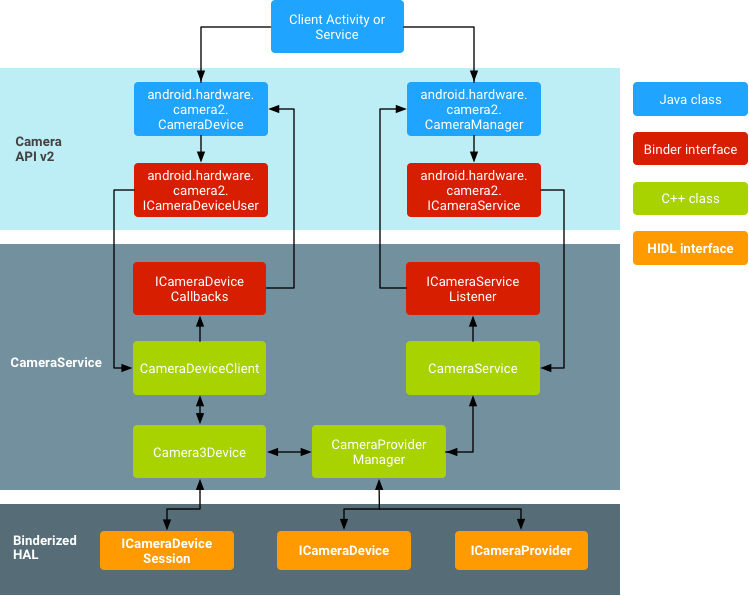Android Camera HAL 介绍
Android Camera HAL 作为 Framework 层 Camera2 API 接口与底层硬件实现的桥梁,起着承上启下的作用。另外从 Android 8.0 开始使用了新的 Treble 架构(HAL 接口与实现代码在 hardware/interfaces/camera/),舍弃了原本旧的架构实现(Legacy HAL: hardware/libhardware/modules/camera/)。
Legacy HAL 当前还保留的内容:
hardware/libhardware/include/hardware/camera*.h, Camera Hal 接口定义,持续更新hardware/libhardware/modules/camera/3_0/,camera.defaultLegacy 默认实现hardware/libhardware/modules/camera/3_4/,camera.v4l2非官方实现(树莓派)0
截止目前最新版本是 HALv3,高端机型基本上都支持。Camera HAL 属于相对比较复杂的一个硬件模块,随着硬件模组的发展,HAL 接口也在不断变化 v1, v2 对应 android.hardware.Camera API, 已经不再被支持。
熟悉了 Android HAL 介绍 ,再来看 Camera HAL 会更容易理解。
Treble 架构下的 Camera HAL

看图说话,简单总结一下:
- Camera 子系统可以分成三层来看,从上到下分别是
App/Framework,CameraService,HAL Impl App/FrameworkvsCameraService之间,通过AIDLbinder 通信CameraServicevsCamera HAL之间,通过HIDLbinder 通信
Treble 架构下,为了满足更多的 IPC binder 调用,提供了 3 个 binder 设备:
/dev/binder, 最早出现的 binder 设备,BnXXX, BpXXX 的 Service/Client 实现基础,Android 8.0之后保留给Android Framework专用,vendor 实现无法访问。/dev/vndbinder, 大部分硬件 HAL 设备使用该节点与上层通信,比如 camera,bluetooth,nfc,sensors/dev/hwbinder, HIDL 实现的进程间通信都可以用
内容比较多,单独更新一篇文章来讲:Android Camera HAL 新架构
Legacy Camera HAL
HAL 接口介绍
模块名称定义如下,加载模块时根据模块名称搜索对应的动态库 camera.variant.so。
1 |
模块接口,camera 通用方法,全局信息的查询。调用时要注意有些方法是无效的,调用前一定要做判空处理,兼容性查询 API 说明。
1 | >>> libhardware/include/hardware/camera_common.h |
Camera HALv1, v2, v3,camera3_device 的定义,注意 device_ops_t 支持的接口不一致。
1 | >>> libhardware/include/hardware/camera3.h |
HALv3 设备功能接口,注意不同子版本对 API 的支持情况不同。因为涉及到底层硬件操作,每个调用有性能要求,同步调用不能超时。
1 | >>> libhardware/include/hardware/camera3.h |
module API version
当前推荐版本是
CAMERA_MODULE_API_VERSION_2_5
1 | >>> include/hardware/camera_common.h |
1 | camera_module_t.common.module_api_version |
- major: MSB 16bit
- minor: LSB 16bit
Versions: 0.X - 1.X [CAMERA_MODULE_API_VERSION_1_0]
- HAL interface 的初版 module 实现
- 透过该版本 module 可打开的 camera 设备,仅仅支持 android.hardware.Camera API
camera_info.device_version无效camera_info.static_camera_characteristics无效
Version: 2.0 [CAMERA_MODULE_API_VERSION_2_0]
- 支持 1.0, 2.0 HAL 接口
camera_info.device_version有效camera_info.static_camera_characteristics在 device_version >= 2.0 时有效
Version: 2.1 [CAMERA_MODULE_API_VERSION_2_1]
- 增加异步回调支持,用来通知 framework 底层状态的变化
set_callbacks必须是该版本及其以上才支持
Version: 2.2 [CAMERA_MODULE_API_VERSION_2_2]
- module 层面增加 vendor tag 支持
vendor_tag_query_ops透过打开的 device 才能调用,不再推荐使用
Version: 2.3 [CAMERA_MODULE_API_VERSION_2_3]
- 支持打开 legacy device
- 前提是 device 具备多个 device API 实现
common.methods->open默认打开的还是最新版本的 device
Version: 2.4 [CAMERA_MODULE_API_VERSION_2_4]
- Torch mode 支持,framework 可以在不打开 device 情况下使用 torch mode;当然 camera device 具有最高优先级使用 flash;当打开相机设备时,HAL 透过 callback 通知 framework torch mode 已关闭
- external camera (例如 USB camera)支持.
CAMERA_DEVICE_STATUS_PRESENT才可获取设备状态,否则无效。framework 注册 callback 接收hot-plug camera 状态,并更新可用的设备列表 - Camera arbitration hints, 增加提示信息:同时打开使用的相机个数,
get_camera_info调用返回后,camera_info.resource_cost,camera_info.conflicting_devices必须被设置 - module 初始化支持,在模块被加载后,其它方法被调用之前,初始化被调用,做一次性的初始化工作
Version: 2.5 [CAMERA_MODULE_API_VERSION_2_5]
- 可查询对象可以是逻辑相机,而不仅仅是物理相机设备
- 增加 stream combination 能力查询
- 完整的设备状态通知,比如 shutter 的 folding/unfolding, covering/uncovering
device API version
当前推荐使用的版本是
CAMERA_DEVICE_API_VERSION_3_5
1 | /** |
Camera device HAL 3.6[ CAMERA_DEVICE_API_VERSION_3_6 ], 是当前推荐支持的版本
- 支持
android.hardware.CameraAPI - 有限的
android.hardware.Camera2API
CAMERA_DEVICE_API_VERSION_3_2 及以上
camera_module_t.common.module_api_version最低要求2.2
CAMERA_DEVICE_API_VERSION_3_1 及以下
camera_module_t.common.module_api_version最低要求2.0
CAMERA_DEVICE_API_VERSION_2_0 及以下
camera_module_t.common.module_api_version要求1.0
1.0: 初版 Android camera HAL (Android 4.0) [camera.h]
- 由 C++
CameraHardwareInterface抽象接口转换而来 - 支持
android.hardware.CameraAPI
2.0: Initial release of expanded-capability HAL (Android 4.2) [camera2.h]
- 完整实现
android.hardware.CameraAPI - 允许 camera service 持有 ZSL queue
- 新增功能尚未做完整测试:manual capture control, Bayer RAW capture, reprocessing of RAW data
3.0: First revision of expanded-capability HAL
- 最低要求 module 版本
2.0及以上 - 重写了 input request 和 stream queue 接口
- 合并
trigger到request里面;合并notification到results - 合并所有
callback到一个结构体里面;合并初始化设置到一个初始化函数调用里 - 合并
stream配置到一个调用里;双向流替换STREAM_FROM_STREAM结构 - 旧版本的有限支持
3.1: Minor revision of expanded-capability HAL
configure_streams传递consumer usage flags到 HALflush调用将丢弃所有未处理完的requests/buffers
3.2: Minor revision of expanded-capability HAL
- 废弃
get_metadata_vendor_tag_ops,使用get_vendor_tag_ops代替 - 废弃
register_stream_buffers,process_capture_request传递给 HAL 的 gralloc buffer 是由 framework 新分配的 - 新增
partial result支持,可以多次调用process_capture_result,获取到的是调用时刻 ready 的结果,是最终结果的子集 - 新增
manual templete到camera3_request_template,应用可直接用来控制拍照设置 - 重写双向流、输入流的定义 spec
- 改变返回结果的路径,由
process_capture_result返回,不再是process_capture_request
3.3: Minor revision of expanded-capability HAL
- API 更新:OPAQUE, YUV reprocessing
- 增加深度图输出支持
camera3_stream_t增加data_space,rotationcamera3_stream_configuration_t增加 camera3 流配置模式
3.4: Minor additions to supported metadata and changes to data_space support
RAW_OPAQUE格式增加ANDROID_SENSOR_OPAQUE_RAW_SIZE参数- Raw 格式增加
ANDROID_CONTROL_POST_RAW_SENSITIVITY_BOOST_RANGE参数 - 重定义
camera3_stream_t.data_space,用法更灵活 - HALv3.2 以上增加如下几个通用 metadata
- ANDROID_INFO_SUPPORTED_HARDWARE_LEVEL_3
- ANDROID_CONTROL_POST_RAW_SENSITIVITY_BOOST
- ANDROID_CONTROL_POST_RAW_SENSITIVITY_BOOST_RANGE
- ANDROID_SENSOR_DYNAMIC_BLACK_LEVEL
- ANDROID_SENSOR_DYNAMIC_WHITE_LEVEL
- ANDROID_SENSOR_OPAQUE_RAW_SIZE
- ANDROID_SENSOR_OPTICAL_BLACK_REGIONS
3.5: Minor revisions to support session parameters and logical multi camera:
- 增加
ANDROID_REQUEST_AVAILABLE_SESSION_KEYSmetadata 参数 - 增加
camera3_stream_configuration.session_parameters, 保存ANDROID_REQUEST_AVAILABLE_SESSION_KEYS对应的初始化值 - 增加 metadata 支持逻辑相机功能
- ANDROID_REQUEST_AVAILABLE_CAPABILITIES_LOGICAL_MULTI_CAMERA
- ANDROID_LOGICAL_MULTI_CAMERA_PHYSICAL_IDS
- ANDROID_LOGICAL_MULTI_CAMERA_SYNC_TYPE
- 增加
camera3_stream.physical_camera_id,逻辑相机应用可以单独设定某个物理相机设备的流配置 - 增加
camera3_capture_request.physcam_settings, 逻辑相机应用可以单独设定某个物理相机设备
3.6: Minor revisions to support HAL buffer management APIs:
- 增加
ANDROID_INFO_SUPPORTED_BUFFER_MANAGEMENT_VERSION,判断是否支持buffer管理 - 增加
camera3_callback_ops_t几个 callback, 3.6 以下未定义,必须置空。request_stream_buffers, 异步callback,向 camera service 申请 output bufferreturn_stream_buffers, 异步callback,返回给 camera service 填好的 output buffersignal_stream_flush, camera service 通知 HAL 即将调用configure_streams, HAL 需要立即完成所有 request 并返回所有 buffers,超时则 camera service 会触发fatal error;如果 HAL 已经返回所有 buffer,则该调用被忽略is_reconfiguration_required, 根据新的session 参数,判断是否要重新配置流
- 增加
CAMERA3_JPEG_APP_SEGMENTS_BLOB_ID
Camera HAL 启动和调用流程
Framework 调用
camera_module_t->common.open(), 返回hardware_device_t结构.Framework 根据
hardware_device_t->version的值,把返回的对象实例转换成对应版本的 device handler; 比如CAMERA_DEVICE_API_VERSION_3_0则转换成camera3_device_tFramework 调用
camera3_device_t->ops->initialize, 必须是在open之后其它功能函数调用之前;如果不需要可以置空。Framework 调用
camera3_device_t->ops->configure_streams, input/output stream参数传递给 HAL注册输出流
CAMERA_DEVICE_API_VERSION_3_1及以下版本,Framework 分配好 gralloc buffer,并调用camera3_device_t->ops->register_stream_buffers,注册输出流,每个流仅需注册一次CAMERA_DEVICE_API_VERSION_3_2及以上版本,camera3_device_t->ops->register_stream_buffers置空
Framework 调用
camera3_device_t->ops->construct_default_request_settings,获取特定 usecase 的默认设置, 可以在 step3 之后的任意时刻调用Framework 基于获取的 usecase 默认设置,调用
camera3_device_t->ops->process_capture_request发起第一个 capture request 到 HAL,至少有一个已注册的输出流,这是一个同步调用,HAL 会block 住直到可以处理下一个 request 才返回CAMERA_DEVICE_API_VERSION_3_2及以上,request 带下来的buffer_handle_t必须是全新的对象
Framework 继续发起 request
- 需要的话调用
construct_default_request_settings获取 usecase 默认设置 - 3.1 及以下,对于尚未注册的输出流,需要调用
register_stream_buffers注册
- 需要的话调用
拍照动作开始,Sensor 开始曝光
- 3.2 及以上,HAL 调用
camera3_callback_ops_t->notify通知上层 SHUTTER event, 包括frame number和timestamp; 因为 framework 必须要有 timestamp 才能 deliver gralloc buffer 给应用,所以notify必须尽可能早 - 3.1 及以下,必须在调用
process_capture_result之前调用notify - partial metadata results 和 gralloc buffer 可以在 SHUTTER event 前或者后发送给 Framework
- 3.2 及以上,HAL 调用
pipeline 处理需要时间,pipeline 处理完,HAL 调用
camera3_callback_ops_t->process_capture_result通知 Framework 返回结果。顺序与发起 request 的顺序一一对应。- 3.2 及以上,返回之前,buffer 对应的
release_fence会被调用,所有权移交给 Framework - HAL 可以调用多次
process_capture_result更新 partial metadata results, Framework 负责合成最终的结果 - 特别地,对于第 N 帧和第 N+1 帧,该回调可以被同时调到
- 3.2 及以上,返回之前,buffer 对应的
一段时间之后,Framework 停止发送 request,并等待所有 capture 处理完成。然后又调用
configure_streams, 这会重置相机硬件和 pipeline,重新配置输入输出流,流可以被复用,并且已注册过的输出流不需要再注册。如果至少有一个注册流,则重复 step7 开始的过程。如果没有注册流,则重复 step5 之后的过程。Framework 调用
camera3_device_t->common->close()关闭相机设备,该调用是同步调用过程,需要等待所有输出返回。close 返回之后,HAL 不再允许调用camera3_callback_ops_t的任何方法当错误发生,或者有异步事件时, HAL 调用
camera3_callback_ops_t->notify()通知 Framework。当发生 fatal error 之后,HAL 应该按照 close 类似的处理流程,取消或强制执行完所有任务之后再调用notify, 确保 Framework 在此期间不会收到任何回调。
